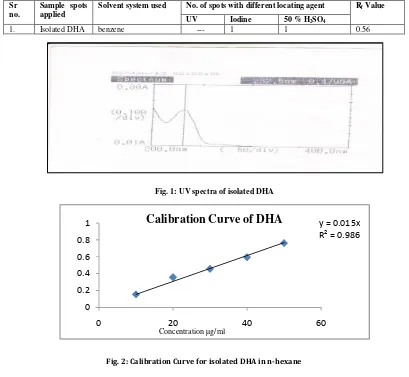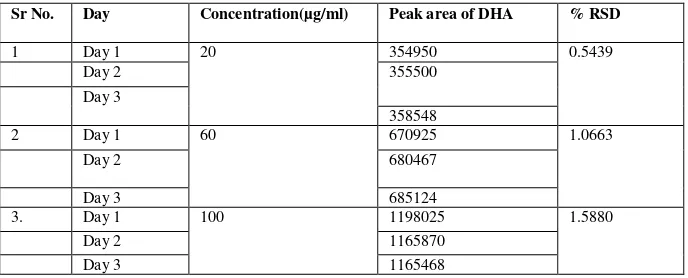ISOLATION OF DOCOSAHEXAENOID ACID FROM FISH
OIL AND ITS VALIDATION BY GAS
CHROMATOGRAPHY
*RASIKA R. NIKHADE1, SHILPA A. DESHPANDE2, SATISH B. KOSALGE1
1
.Hi-Tech College of Pharmacy, Chandrapur-442406. (M. S.) INDIA 2
.Sharad Pawar College of Pharmacy, Wanadongri, Hingna road, Nagpur- 441110. (M. S.) INDIA
Date Received: 28TH Jan 2014
Date of Accepted: 4th Feb 2014
Date Published: 23-Feb-2014
126
Abstract:
Docosahexaenoic acid (DHA) was isolated from fish oil and identified by gas chromatography. The isolation of DHA was carried out by the column chromatography. The preparation of column using silica gel 60-120 mesh and elution of column with different solvent in increasing order of polarity was done. Isolated fractions were subjected to identification test for DHA by thin layer chromatography using solvent benzene. Determination of isolated DHA was carried out by gas chromatography using reagent hexane as a solvent. The chromatogram of isolated DHA and standard DHA were compared. It was showed that in thin layer chromatography the fraction 51-58 and 72-85 showed single spot in benzene mobile phase having Rf value 0.56 when compared with standard DHA which matched with Rf Value of standard DHA. The retention time of isolated DHA and standard DHA by gas chromatography were 5.73 and 5.01 respectively. Isolated DHA showed 95.21 percentage purity. It was observed that fish oil was used as precursor of DHA and the developed method of column chromatographic isolation of DHA and its validation by GC is simple, accurate and precise.
Keywords:
Docosahexaenoic acid, Column chromatography, Thin layer chromatography, Gas chromatography
Introduction
The health benefits of fish oil include its ability to aid in treatment of heart diseases, high cholesterol, depression, anxiety, low immunity, cancer, diabetes, inflammation, arthritis, AIDS, Alzheimer’s disease, eye disorders, macular degeneration and ulcers. Most of the these health benefits of fish oil can be attributed to the presence of Omega 3 essential fatty acids such as Docosahexaenoic acid (DHA) and Eicosapentaenoic acid (EPA).1,2 The most common names among these for obtaining fish oil are albacore tuna, herring, mackerel, sardines, lake trout and salmon. Gas chromatography (GC) is a common type of chromatography used in analytical chemistry for separating and analyzing compounds that can be vaporized without decomposition. Typical uses of GC include testing the purity of a particular substance, or separating the different components of a mixture (the relative amounts of such components can also be determined). Gas chromatography specifically gas-
liquid chromatography involves a sample being vaporized and injected onto the head of the chromatographic column. The sample is transported through the column by the flow of inert, gaseous mobile phase. The different components in the mixture pass through the column at different rates due to differences in their partitioning behavior between the two mobile phases.3
MATERIALS AND METHODS:
DHA was supplied by Central India Pharmaceuticals, MIDC, Nagpur Fish oil was obtained from Janta Aqua Fisheries Udupi, Karnataka. Other chemicals were of analytical grade. UV spectrophotometer (UV 1700 Shimadzu Japan), Gas Chromatograph (Thermo scientific Trace GC 600 with fused silica capillary column) were used in this study.
127
Isolation of DHA from fish oil by column chromatography:
As fish oil has higher concentration of DHA it was used for isolation and the procedure was carried out by column chromatography. For every solvent or
solvent mixture, 30 ml of each fraction was collected in a conical flask, distilled to remove solvent, concentrated fraction were collected in a test tube. Then concentrated fractions were subjected to thin layer chromatography by using different solvent system and 50% H2SO4 and iodine as detecting reagents.4
Table 1: Chromatographic conditions
Table 2: column chromatography
Sr no. Solvents used for elution Fraction no
1 Petroleum ether 1-6
2 Petroleum ether : n-hexane (90:10) 7-14
3 Petroleum ether : n-hexane (80:20) 15-21
4 Petroleum ether : n-hexane (70:30) 22-29
5 Petroleum ether : n-hexane (60:40) 30-37
6 Petroleum ether : n-hexane (50:50) 38-44
7 Petroleum ether : n-hexane (40:60) 45-50
8 Petroleum ether : n-hexane (30:70) 51-58
9 Petroleum ether : n-hexane (20:80) 59-66
10 Petroleum ether : n-hexane (10:90) 67-71
11 n-hexane 72-76
12 n-hexane : Chloroform (99:1) 77-85
13 n-hexane : Chloroform (98:2) 86-91
14 n-hexane : Chloroform (97:3) 92-101
15 n-hexane : Chloroform (96:4) 102-111
16 n-hexane : Chloroform (95:5) 112-121
17 n-hexane : Chloroform (94:6) 122-130 Instrument Thermo scientific Gas Chromatograph Column fused silica capillary column
Column dimension 30 m X 0.25 mm ID X 0.25 µm film thickness Carrier gas Nitrogen
Detector Flame ionization detector Flow 1-2ml /minutes
128
Table 3:Thin layer Chromatography of Isolated DHAFig. 1: UV spectra of isolated DHA
Fig. 2: Calibration Curve for isolated DHA in n-hexane
Fig 3: Chromatogram of standard DHA
Table 4: for chromatogram of standard DHA
Sr no. Peaks Drug sample Ret time (min) Area (µ*V*Sec) Peak height
1 1 Chloroform 3.933 6629819 127235
2 2 Standard DHA 5.011 200202 2332
Sr no.
Sample spots applied
Solvent system used No. of spots with different locating agent Rf Value
UV Iodine 50 % H2SO4
1. Isolated DHA benzene --- 1 1 0.56
y = 0.015x R² = 0.986
0 0.2 0.4 0.6 0.8 1
0 20 40 60
Calibration Curve of DHA
129
Analysis of isolated DHA:
Analysis of isolated DHA was done using UV spectrophotometer by determination of λmax.5 An accurately weighed 25 mg of standard and isolated DHA was dissolved in sufficient quantity of chloroform in 25 ml of volumetric flask later. Then, 1.0 µl of sample was injected manually into injector of gas chromatography.6 The developed method of gas chromatographic identification of DHA was then validated by studying the Accuracy, Ruggedness (intraday and interday study) and Robustness (change in carrier gas pressure and change in initial oven temperature).
Discussion and Conclusion:
DHA was isolated from fish oil by column chromatography by using different solvents in increasing order of polarity. Mobile phase of benzene showed maximum resolution and reproducible results. The isolated oil showed the UV spectrum at 232.5 nm (fig. 1) and from the standard calibration curve of isolated DHA (fig. 2) in n-hexane it was concluded that drug obeys Beer-Lambert’s law. From the gas chromatography analysis the percentage purity of isolated compound was found out to be 95.21%.The proposed method for GC was very sensitive, quick, precise and suitable for routine determination of Docosahexaenoic acid.
VALIDATION:
Accuracy:
Sr no. Blanksolutionwith spiked analyte in %(µG) Area under curve Recovery (%)
1 50%
346725
98.18 353354
354580
2 100%
474680
99.69 483881
482321
3 150%
588435
99.49 614162
601935
Mean 99.45
% RSD 0.8275
Ruggedness:
Table-7: For Intraday Study Sr
No. Day
Concentration
(µg/ml). Peak area of DHA % RSD 1 Morning
20
358315
1.3067
Afternoon 357625
Evening 349951
2 Morning
\60
728931
0.7712
Afternoon 732251
Evening 723983
3. Morning
100
1198025
0.5340
Afternoon 1210005
130
Sr No. Day Concentration(µg/ml) Peak area of DHA % RSD
1 Day 1 20 354950 0.5439
Day 2 355500
Day 3
358548
2 Day 1 60 670925 1.0663
Day 2 680467
Day 3 685124
3. Day 1 100 1198025 1.5880
Day 2 1165870
Day 3 1165468
Table 8:: Results for inter day study
Table 9 :Change in carrier gas pressure
Sr no. Parameter Concentration(µg/ml) Peak area Observation
1 Carrier gas pressure
73 Kpa 20
352950
75.5 Kpa 352900
352948
2 %RSD 0.5487
Table 10 :Change in initial oven temperature
Sr no. Parameter Concentratio (µg/ml) Peak area Observation
1 Initial oven temperature 110ºC
20 352950 140º C
353600 356650
2 % RSD 0.50574
References:
1. Horrocks LA, Yeo YK. Health benefits of docosahexaenoic acid (DHA). Pharmacol Res 1999; 40:211-25.
2. http://en.wikipedia.org/wiki/omega 3 fatty acids retrieved on 19.08.2012/4.15 pm
3. Chatwal GR & Anand SK. Instrumental methods of chemical analysis. 5th ed. Himalaya publishing house; 2010; P.264-267.
4. Stahl E. Thin layer chromatography. 2nd ed. Springer-Verlay Berlin Publisher; 2005; 2-10. 5. Silverstein RM, Spectrometric identification of
organic compound. 7th ed. California A Wiley-Interscience Publication, 2005; 2-200.
6. Fournier V, Destaillats F, Hug B. Quantification of eicosapentanoic acid and docosahexaenoic acid geometrical isomers formed during fish oil deodorization by gas-liquid chromatography. J Chromatography a 2007; 1154:353-59.


